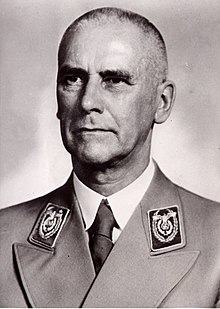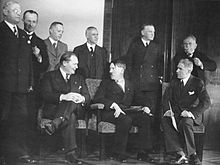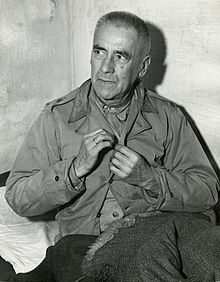Wilhelm Frick
Wilhelm Frick | |
|---|---|
 Wilhelm Frick,c. 1940-45 | |
| Reichsministerof the Interior | |
| In office 30 January 1933 – 20 August 1943 | |
| President | Paul von Hindenburg (1933–1934) Adolf Hitler (1934–1943; asFührer) |
| Chancellor | Adolf Hitler |
| Preceded by | Franz Bracht |
| Succeeded by | Heinrich Himmler |
| General Plenipotentiary for Administration of the Reich | |
| In office 4 September 1938[1]– 20 August 1943 | |
| Appointed by | Adolf Hitler |
| Preceded by | Office established |
| Succeeded by | Heinrich Himmler[2] |
| Protector of Bohemia and Moravia | |
| In office 24 August 1943 – 8 May 1945 | |
| Appointed by | Adolf Hitler |
| Preceded by | Konstantin von Neurath(de jure) Kurt Daluege(de facto) |
| Succeeded by | Position abolished |
| Reichsministerwithout Portfolio | |
| In office 24 August 1943 – 30 April 1945 | |
| Additional positions | |
| 1939–1945 | Member of theCouncil of Ministers for the Defense of the Reich |
| 1934—1945 | Member of thePrussian State Council |
| 1933—1945 | Reichsleiter |
| 1933–1945 | Member of theReichstag (Nazi Germany) |
| 1924—1933 | Member of theReichstag (Weimar Republic) |
| Personal details | |
| Born | 12 March 1877 Alsenz,Kingdom of Bavaria,German Empire |
| Died | 16 October 1946(aged 69) Nuremberg Prison,Nuremberg,Bavaria,Allied-occupied Germany |
| Cause of death | Execution by hanging |
| Political party | Nazi Party |
| Spouses |
|
| Children | 5 |
| Alma mater | |
| Occupation | Attorney |
| Signature |  |
| Criminal conviction | |
| Criminal status | Executed |
| Conviction(s) | Crimes of aggression War crimes Crimes against humanity |
| Trial | Nuremberg trials |
| Criminal penalty | Death |
Wilhelm Frick(12 March 1877 – 16 October 1946) was a convicted war criminal and prominent German politician of theNazi Party(NSDAP) who served as Minister of theInteriorinAdolf Hitler'scabinetfrom 1933 to 1943[3]and as the last governor of theProtectorate of Bohemia and Moravia.
As the head of theKriminalpolizei(criminal police) in Munich, Frick took part in Hitler's failedBeer Hall Putschof 1923, for which he was convicted ofhigh treason.He managed to avoid imprisonment and soon afterwards became a leading figure of the Nazi Party (NSDAP) in theReichstag.After Hitler becameChancellor of Germanyin 1933, Frick joined the new government and was named Minister of the Interior. Additionally, on 21 May 1935, Frick was namedGeneralbevollmächtigter für die Reichsverwaltung(General Plenipotentiary for the Administration of the Reich).[4]He was instrumental in formulating laws that consolidated the Nazi regime (Gleichschaltung), as well as laws that defined theNazi racial policy,most notoriously theNuremberg Laws.On 30 August 1939, immediately prior to the outbreak of theSecond World War,Frick was appointed by Hitler to the six-personCouncil of Ministers for Defense of the Reichwhich operated as a war cabinet.[5]Following the rise of theSS,Frick gradually lost favour within the party, and in 1943 he was replaced byHeinrich Himmleras interior minister. Frick remained in the cabinet as a minister without portfolio until Hitler's death in 1945.
After World War II, Frick was tried and convicted ofwar crimesat theNuremberg trialsandexecutedbyhanging.
Early life
[edit]Born in thePalatinatemunicipality ofAlsenz,then part of theKingdom of Bavaria,Germany, the last of four children of Protestant teacher Wilhelm Frick sen. (d. 1918) and his wife Henriette (née Schmidt). He attended thegymnasiuminKaiserslautern,passing hisAbiturexams in 1896. He went on studyingphilologyat theUniversity of Munich,but soon after turned to study law atHeidelbergandHumboldt University of Berlin.He received his doctorate of law in 1901. He joined the Bavarian civil service in 1903, working as an attorney at theMunich Police Department.He was appointed aBezirksamtassessorinPirmasensin 1907 and became acting district executive in 1914. Rejected as unfit, Frick did not serve in World War I. He was promoted to the official rank of aRegierungsassessorand, at his own request, re-assumed his post at the Munich Police Department in 1917.[6]
On 25 April 1910, Frick married Elisabetha Emilie Nagel (1890–1978) in Pirmasens. They had two sons and a daughter. The marriage ended in an ugly divorce in 1934. A few weeks later, on 12 March, Frick remarried inMünchbergMargarete Schultze-Naumburg (1896–1960), the former wife of the NaziReichstagMPPaul Schultze-Naumburg.Margarete gave birth to a son and a daughter.
Nazi career
[edit]
In Munich, Frick witnessed the end of the war and theGerman Revolution of 1918–1919.He sympathized with right-wingFreikorpsparamilitary units. Chief of PoliceErnst Pöhnerintroduced him toAdolf Hitler,whom he helped willingly with obtaining permission to hold political rallies and demonstrations.
Elevated to the rank of anOberamtmannand head of the Political department of the Munich police from 1923, he and Pöhner participated in Hitler's failedBeer Hall Putschon 9 November. Frick tried to suppress theState Police's operation, wherefore he was arrested and imprisoned, and tried for aiding and abettinghigh treasonby thePeople's Courtin April 1924. After several months in custody, he was given a suspended sentence of 15 months' imprisonment and was dismissed from his police job. Later during the disciplinary proceedings, the dismissal was declared unfair and revoked, on the basis that his treasonous intention had not been proven. Frick went on to work at the Munichsocial insuranceoffice from 1926 onwards, in the rank of aRegierungsrat1st class by 1933.
In the aftermath of the putsch, Wilhelm Frick was elected a member of the GermanReichstagparliament in thefederal election of May 1924.He had been nominated by theNational Socialist Freedom Movement,anelectoral listof the far-rightGerman Völkisch Freedom Partyand thenbannedNazi Party.On 1 September 1925, Frick joined the re-established Nazi Party. On 20 May 1928, he was one of the first 12 deputies elected to theReichstagas Nazi Party members. He associated himself with the radicalGregor Strasser;making his name by aggressive anti-democratic andantisemiticReichstag speeches, he climbed to the post of the Naziparliamentary group leader(Fraktionsführer) in 1928.[7]He would continue to be elected to theReichstagin every subsequent election in the Weimar and Nazi regimes.
In 1929, as the price for joining thecoalition governmentof theLand(state) ofThuringia,the NSDAP received the state ministries of the Interior and Education. On 23 January 1930, Frick was appointed to these ministries, becoming the first Nazi to hold a ministerial-level post at any level in Germany (though he remained a member of the Reichstag).[8]Frick used his position to dismissCommunistandSocial Democraticofficials and replace them with Nazi Party members, so Thuringia's federal subsidies were temporarily suspended by Reich MinisterCarl Severing.Frick also appointed the eugenicistHans F. K. Güntheras a professor ofsocial anthropologyat theUniversity of Jena,banned several newspapers, and bannedpacifistdrama and anti-war films such asAll Quiet on the Western Front.He was removed from office by a Social Democraticmotion of no confidencein the ThuringianLandtagparliament on 1 April 1931.
Reich Minister
[edit]
When Reich presidentPaul von Hindenburgappointed Hitler chancellor on30 January 1933,Frick joined his government asReichsministerof the Interior. Together with Reichstag PresidentHermann Göring,he was one of only two NaziReichsministersin the original Hitler Cabinet, and the only one who actually had a portfolio; Göring served asminister without portfoliountil 5 May. Though Frick held a key position, especially in organizing thefederal elections of March 1933,he initially had far less power than his counterparts in the rest of Europe. Notably, he had no authority over the police; in Germany law enforcement has traditionally been astateand local matter. Indeed, the main reason that Hindenburg andFranz von Papenagreed to give the Interior Ministry to the Nazis was that it was almost powerless at the time. A mighty rival arose in the establishment of thePropaganda MinistryunderJoseph Goebbelson 13 March.
Frick's power dramatically increased as a result of theReichstag Fire Decreeand theEnabling Act of 1933.The provision of the Reichstag Fire Decree giving the cabinet the power to take over state governments on its own authority was actually his idea; he saw the fire as a chance to increase his power and begin the process of Nazifying the country.[9]He was responsible for drafting many of theGleichschaltunglaws that consolidated the Nazi regime.[4]Within two weeks of the Enabling Act's passage, Frick helped draft the "Second Law on the Coordination of the States with the Reich"(7 April 1933) appointingReichsstatthalter(Reich Governors) to take over the state governments. He also initiated and drafted theLaw Against the Formation of Parties(14 July 1933) that formally made the NSDAP the only legal party in Germany. Under the 30 January 1934 "Law on the Reconstruction of the Reich",which converted Germany into a highly centralized state, state parliaments were dissolved and the newly implementedReichsstatthalterwere made directly responsible to him. He also drafted theLaw on the Abolition of the Reichsrat(14 February 1934) that abolished the upper chamber of the Reich parliament.[10]Frick also was made a member ofHans Frank'sAcademy for German Law.[11]On 10 October 1933, Hitler appointed him aReichsleiter,the second highest political rank in the Nazi Party. On 1 May 1934, he replacedMinister-PresidentGöring asPrussianMinister of the Interior, which gave him control over the police in Prussia. As a member of the Prussian cabinet, he also became anex officiomember of thePrussian State Council.[12]By 1935, he also had near-total control over local government. He had the sole power to appoint the mayors of all municipalities with populations greater than 100,000 (except for thecity statesofBerlinandHamburg,where Hitler reserved the right to appoint the mayors himself if he deemed it necessary). He also had considerable influence over smaller towns as well; while their mayors were appointed by the state governors, as mentioned earlier the governors were responsible to him.

Frick was instrumental in theracial policy of Nazi Germanydrafting laws againstJewishcitizens, like the "Law for the Restoration of the Professional Civil Service"and the notoriousNuremberg Lawsin September 1935.[7]Already in July 1933, he had implemented theLaw for the Prevention of Hereditarily Diseased Offspringincludingforced sterilizations,which later culminated in the killings of theAction T4"euthanasia" programme supported by his ministry. Frick also took a leading part inGermany's re-armamentin violation of the 1919Versailles Treaty.He drafted laws introducing universal military conscription and extending theWehrmachtservice law toAustriaafter the 1938Anschluss,as well as to the "Sudetenland"territories of theFirst Czechoslovak Republicannexed according to theMunich Agreement.
In the summer of 1938 Frick was named the patron(Schirmherr)of theDeutsches Turn- und SportfestinBreslau,a patriotic sports festival attended by Hitler and much of the Nazi leadership. In this event he presided the ceremony of "handing over" the newNazi Reich Sports League(NSRL) standard toReichssportführerHans von Tschammer und Osten,marking the further nazification of sports in Germany. On 11 November 1938, Frick promulgated the Regulations Against Jews' Possession of Weapons.
From the mid-to-late 1930s Frick lost favour irreversibly within the Nazi Party after a power struggle involving attempts to resolve the lack of coordination within the Reich government.[13]For example, in 1933 he tried to restrict the widespread use of "protective custody" orders that were used to send people to concentration camps, only to be begged off byReichsführer-SSHeinrich Himmler.His power was greatly reduced in June 1936 when Hitler named Himmler the Chief of German Police, which effectively united the police with the SS. On paper, Frick was Himmler's immediate superior. In fact, the police were now independent of Frick's control, since the SS was responsible only to Hitler.[14][15]A long-running power struggle between the two culminated in Frick's being replaced by Himmler asReichsministerof the Interior in August 1943. However, he remained in the cabinet as aReichsministerwithout portfolio. Besides Hitler, he andLutz Graf Schwerin von Krosigkwere the only members of theThird Reich's cabinetto serve continuously from Hitler's appointment as Chancellor until his death.
Frick's replacement asReichsministerof the Interior did not reduce the growing administrative chaos and infighting between party and state agencies.[16]Frick was then appointed asProtector of Bohemia and Moravia,making him Hitler's personal representative in theCzech lands.Its capitalPrague,where Frick used ruthless methods to counter dissent, was one of the lastAxis-held cities to fall at theend of World War II in Europe.[17]
Trial and execution
[edit]

Frick was arrested, and was arraigned at theNuremberg trials,where he was the only defendant besidesRudolf Hesswho refused to testify on his own behalf.[18]Frick was convicted of planning, initiating and waging wars of aggression,war crimesandcrimes against humanity,and for his role, as Minister of the Interior, in formulating theEnabling Actand theNuremberg Laws– laws under which people were deported toconcentration camps,many of them being murdered there. Frick was also accused of being one of the most senior people responsible for the existence of the concentration camps.[19]
Frick was sentenced to death on 1 October 1946,and washangedat Nuremberg Prison on 16 October. Of his execution, journalist Joseph Kingsbury-Smith wrote:
The sixth man to leave his prison cell and walk with handcuffed wrists to the death house was 69-year-old Wilhelm Frick. He entered the execution chamber at 2.05 am, six minutes afterRosenberghad been pronounced dead. He seemed the least steady of any so far and stumbled on the thirteenth step of the gallows. His only words were, "Long live eternal Germany", before he was hooded and dropped through the trap.[20]
His body, along with those of the other nine executed men and the corpse ofHermann Göring,was cremated at theOstfriedhof CemeteryinMunich,and the ashes were scattered in the riverIsar.[21][22][23]
See also
[edit]References
[edit]- ^Office of United States Counsel for Prosecution of Axis Criminality (1948).Nazi Conspiracy And Aggression: Supplement B.United States Government Printing Office. p. 408.
- ^Lisciotto, Carmelo (2007)."SS & Other Nazi Leaders".Holocaust Research Project.Retrieved18 April2024.
- ^Claudia Koonz,The Nazi Conscience,p 103,ISBN0-674-01172-4
- ^ab"Nazi Germany - Government Structure".Retrieved8 May2023.
- ^Broszat, Martin (1981).The Hitler State.Longman Inc. pp. 308–309.ISBN0-582-49200-9.
- ^Biographie, Deutsche."Frick, Wilhelm - Deutsche Biographie".deutsche-biographie.de.
- ^ab"Index Fo-Fy".rulers.org.
- ^"Nurnbergprocessen 1".bjornetjenesten.dk.Archived fromthe originalon 14 January 2009.Retrieved7 December2008.
- ^Evans, Richard J.(2003).The Coming of the Third Reich.New York City:Penguin Press.ISBN978-0141009759.
- ^"Nazi Conspiracy and Aggression, Office of the United States Chief of Counsel for Prosecution of Axis Criminality (" Red Series "): Volume 5, pp. 658–659".Library of Congress, Washington, D.C. 20540 USA.Retrieved8 May2023.
- ^"Nazi Conspiracy and Aggression, Office of the United States Chief of Counsel for Prosecution of Axis Criminality (" Red Series "): Volume 5, p. 231, Document 2481-PS".Library of Congress, Washington, D.C. 20540 USA.Retrieved8 May2023.
- ^Lilla, Joachim (2005).Der Prußische Staatsrat 1921–1933: Ein biographisches Handbuch.Düsseldorf: Droste Verlag. pp. 31, 295.ISBN978-3-770-05271-4.
- ^A legalistic follower, rather than an initiator, Frick the servant increasingly lost favour with his master, apparently because he misunderstood the basic nature of the Fuhrer's governance. Whereas the Third Reich thrived on inconsistencies, rivalries, and constant evolutionary change, Frick's juristic mind longed for order and legal stabilization. The incongruity wasinsuperableand it was thus logical enough that in 1943 the minister, whose share of practical power had rapidly diminished in the second half of the 1930s, ultimately even lost his official post.Udo Sautter, Canadian Journal of History
- ^Longerich, Peter (2012).Heinrich Himmler: A Life,Oxford University Press, p. 204.
- ^Williams, Max (2001).Reinhard Heydrich: The Biography: Volume 1,Ulric, p. 77.
- ^"Hans Mommsen,The Dissolution of the Third Reich (1943–1945)".Archived fromthe originalon 7 August 2008.Retrieved8 May2023.
- ^Trial:Wilhelm FrickArchived2 December 2008 at theWayback Machine
- ^"The trial of German major war criminals: proceedings of the International Military Tribunal sitting at Nuremberg Germany".avalon.law.yale.edu.
- ^"Nuremberg Trial Defendants: Wilhelm Frick".jewishvirtuallibrary.org.
- ^Joseph Kingsbury-Smith, who witnessed the execution of Wilhelm Frick and nine other leaders of the Nazi Party on 1st October 1946Archived24 October 2008 at theWayback Machine
- ^Thomas Darnstädt (2005),"Ein Glücksfall der Geschichte",Der Spiegel,13 September, no. 14, p. 128
- ^Manvell 2011,p. 393.
- ^Overy 2001,p. 205.
Sources
[edit]- Manvell, Roger (2011) [1962].Goering.Skyhorse.ISBN978-1-61608-109-6.
- Overy, Richard J.(2001).The Battle of Britain: The Myth and the Reality.New York: W.W. Norton.ISBN978-0-393-02008-3.
Further reading
[edit]External links
[edit] Quotations related toWilhelm Frickat Wikiquote
Quotations related toWilhelm Frickat Wikiquote Media related toWilhelm Frickat Wikimedia Commons
Media related toWilhelm Frickat Wikimedia Commons- Newspaper clippings about Wilhelm Frickin the20th Century Press Archivesof theZBW
- 1877 births
- 1946 deaths
- Christian fascists
- Executed German mass murderers
- Executed people from Rhineland-Palatinate
- German people convicted of the international crime of aggression
- German people convicted of war crimes
- German police chiefs
- German police officers convicted of crimes against humanity
- German Protestants
- German Völkisch Freedom Party politicians
- Heidelberg University alumni
- Interior ministers of Germany
- Interior ministers of Prussia
- Holocaust perpetrators in Germany
- Humboldt University of Berlin alumni
- Jurists from Rhineland-Palatinate
- Lawyers in the Nazi Party
- Ludwig Maximilian University of Munich alumni
- Members of the Academy for German Law
- Members of the Prussian State Council (Nazi Germany)
- Members of the Reichstag 1924–1928
- Members of the Reichstag 1924
- National Socialist Freedom Movement politicians
- Government ministers of Nazi Germany
- Nazis who participated in the Beer Hall Putsch
- People convicted of treason against Germany
- Police officers convicted of treason
- People executed by the International Military Tribunal in Nuremberg
- Police officers executed for crimes against humanity
- People from Donnersbergkreis
- Politicians from the Kingdom of Bavaria
- Protectorate of Bohemia and Moravia
- Reichsleiters
- Thule Society members
- Members of the Reichstag 1928–1930
- Members of the Reichstag 1930–1932
- Members of the Reichstag 1932
- Members of the Reichstag 1932–1933
- Members of the Reichstag 1933
- Members of the Reichstag 1933–1936
- Members of the Reichstag 1936–1938
- Members of the Reichstag 1938–1945
